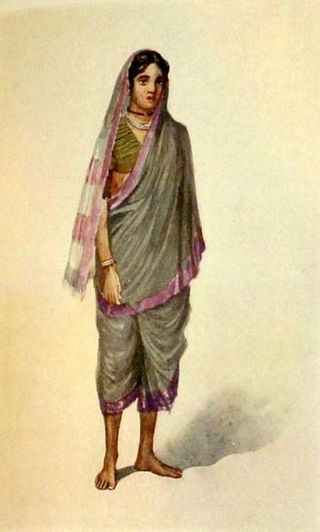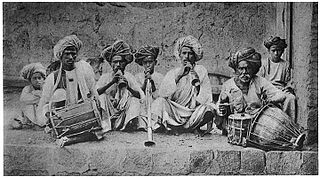Related Research Articles
The Maratha caste is composed of 96 clans, originally formed in the earlier centuries from the amalgamation of families from the peasant (Kunbi), shepherd (Dhangar), blacksmith (Lohar), carpenter (Sutar), Bhandari, Thakar and Koli castes in Maharashtra. Many of them took to military service in the 16th century for the Deccan sultanates or the Mughals. Later in the 17th and 18th centuries, they served in the armies of the Maratha Empire, founded by Shivaji, a Maratha Kunbi by caste. Many Marathas were granted hereditary fiefs by the Sultanates, and Mughals for their service.
The Patil is an Indian last name and a title or surname. The female variant of the title is Patlin or Patlinbai, and is also used to describe the wife of a Patil.
Deshastha Brahmin is a Hindu Brahmin subcaste mainly from the Indian state of Maharashtra and North Karnataka. Other than these states, according to authors K. S. Singh, Gregory Naik and Pran Nath Chopra, Deshastha Brahmins are also concentrated in the states of Telangana (which was earlier part of Hyderabad State and Berar Division), Andhra Pradesh and Madhya Pradesh (Which was earlier part of Central Provinces and Berar) Historian Pran Nath Chopra and journalist Pritish Nandy say, "Most of the well-known saints from Maharashtra, Karnataka and Andhra Pradesh were Deshastha Brahmins". The mother tongue of Deshastha Brahmins is either Marathi, Kannada or Telugu.

Mahar is a caste found largely in the state of Maharashtra and neighbouring areas. Previously they along with many other Hindu castes were treated as untouchables. The injustice of this practice was the primary reason for most of the Mahar community to follow B. R. Ambedkar in embracing Buddhism in the middle of the 20th century. There are still some Mahars who practice Hinduism.

The Mahar Regiment is an infantry regiment of the Indian Army. Although it was originally intended to be a regiment consisting of troops from the Mahar community of Maharashtra, today the Mahar Regiment is composed of different communities from mainly states like Maharashtra, Gujarat, Madhya Pradesh, Uttar Pradesh, and Bihar.
Deshpande is a surname native to the Indian states of Maharashtra, Goa and Karnataka. The surname can be also found in some parts of Andhra Pradesh. Deshpande surname is found among the Deshastha Brahmins, Gaud Saraswat Brahmins (GSB) and the Chandraseniya Kayastha Prabhus (CKP).
The Maratha Clan System refers to the 96 Maratha clans. The clans together form the Maratha caste of India. These Marathas primarily reside in the Indian state of Maharashtra, with smaller regional populations in other states.

The Marathi people or Marathis are an Indo-Aryan ethnolinguistic group who are native to Maharashtra in western India. They natively speak Marathi, an Indo-Aryan language. Maharashtra was formed as a Marathi-speaking state of India on May 1, 1960, as part of a nationwide linguistic reorganisation of the Indian states. The term "Maratha" is generally used by historians to refer to all Marathi-speaking peoples, irrespective of their caste; However, it may refer to a Maharashtrian caste known as the Maratha.

Maharashtra is the third largest state of India in terms of land area and second largest in terms of population in India. It has a long history of Marathi saints of Varakari religious movement, such as Dnyaneshwar, Namdev, Chokhamela, Eknath and Tukaram which forms the one of bases of the culture of Maharashtra or Marathi culture. Maharashtrian culture had large influence over neighbouring regions under the Maratha Empire.
The Vatandar, or Watandar is an Indian term meaning "landholder". The title was given to landowners, particularly in Maharashtra.
Marathi Brahmins are communities native to the Indian state of Maharashtra. They are classified into mainly three sub-divisions based on their places of origin, "Desh", "Karad" and "Konkan". The Brahmin subcastes that come under Maharashtra Brahmins include Deshastha, Chitpavan (Konkanastha), Saraswat, Karhade, and Devrukhe.
The jajmani system or yajman system was an economic system most notably found in villages of the Indian subcontinent in which lower castes performed various functions for upper castes and received grain or other goods in return. It was an occupational division of labour involving a system of role-relationships that enabled villages to be mostly self-sufficient.

Maharashtra is a state in the western region of India. It is India's second-most populous state and third-largest state by area. The region that comprises the state has a long history dating back to approximately 1300–700 BCE, although the present-day state was not established until 1960 CE.

The Mang, or Matang, community is an Indian caste mainly residing in the state of Maharashtra. Matang are known as Madiga "kommati" in Telangana, Andhra Pradesh and Karnataka.
The Gurav are an occupational community comprising several castes. They are among the traditional service providers found in villages, for whom they act in a priest role, and are found in several states of India.
Gopal Baba Walangkar, also known as Gopal Krishna, is an early example of an activist working to release the untouchable people of India from their historic socio-economic oppression, and is generally considered to be the pioneer of that movement. He developed a racial theory to explain the oppression and also published the monthly journal Vital-Vidhvansak, targeted at the Brahmanical Orthodoxy.
Potdar is a hereditary title and a surname native to the Indian state of Maharashtra. This surname is mainly found among the Panchal Sonar, Deshastha Brahmin and Karhade Brahmin communities. Potdar is part of Maratha revenue system, as well as the local administrative body in the state of Maharashtra.
Chambhar is caste from Indian state of Maharashtra, and Northern Karnataka. Their traditional occupation was leather work. Historically subject to untouchability, they were traditionally outside the Hindu ritual ranking system of castes known as varna. Castes with similar traditional occupation are found throughout the Indian subcontinent such as Chamar in Northern india, and Mochi in Gujarat.
Ghorpade is a surname and family name found among Marathas, Marathi Brahmins, Mahar and even Chambhar caste in the Indian states of Maharashtra and Karnataka and may refer to members of the Ghorpade Dynasty.
The Lokhande is a clan (Gotra) found amongst the Koli, Maratha, Mang, Mahar, Ramoshi, Brahmin, mainly in the state of Maharashtra in India but it also appears in Indian states bordering Maharashtra. Lokhande means the person who deals with iron or ironmonger.
References
- ↑ Kulkarni, A. R. "Social and Economic Position of Brahmins in Maharashtra in the Age of Shivaji." Proceedings of the Indian History Congress, vol. 26, 1964, pp. 66–75. JSTOR, https://www.jstor.org/stable/44140322. Accessed 15 June 2020.
- ↑ Fukazawa, Hiroshi. “RURAL SERVANTS IN THE 18TH CENTURY MAHARASHTRIAN VILLAGE—DEMIURGIC OR JAJMANI SYSTEM?” Hitotsubashi Journal of Economics, vol. 12, no. 2, 1972, pp. 14–40. JSTOR, https://www.jstor.org/stable/43295541. Accessed 29 Jan. 2024.
- ↑ Altekar, Anant Sadashiv. A History of Village Communities in Western India. No. 5. H. Milford, Oxford University Press, 1927.
- ↑ Jaffrelot, Christopher (2005). Dr. Ambedkar and untouchability : fighting the Indian caste system. New York: Columbia Univ. Press. p. 20. ISBN 9780231136020.
- ↑ Kulkarni, A. R. (2000). "The Mahar Watan: A Historical Perspective". In Kosambi, Meera (ed.). Intersections: Socio-Cultural Trends in Maharashtra. London: Sangam. pp. 121–140. ISBN 978-0863118241 . Retrieved 13 December 2016.
- ↑ Sugandhe, Anand, and Vinod Sen. "Scheduled Castes in Maharashtra: Struggle and Hurdles in Their Socio-Economic Development". Journal of Indian Research (ISSN: 2321-4155) 3.3 (2015): 53-64.
- ↑ Fukazawa, H., 1972. Rural Servants in the 18th Century Maharashtrian Village—Demiurgic or Jajmani System?. Hitotsubashi journal of economics, 12(2), pp.14-40.